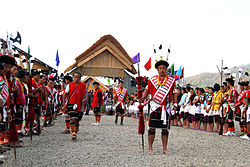Naga Hills
| Naga Hills | |
|---|---|
| Highest point | |
| Peak | Mount Saramati |
| Geography | |
| Countries | India and Burma |
| Range coordinates | 26°N 95°E / 26°N 95°ECoordinates: 26°N 95°E / 26°N 95°E |

The Naga Hills, reaching a height of around 3,825 metres (12,549 ft), lie on the border of India and Burma (Myanmar).[citation needed] They are part of a complex mountain system, and the parts of the mountain ranges[citation needed] inside the Indian state of Nagaland and the Burmese Naga Self-Administered Zone are called the Naga Hills. The highest point of the Naga hills is Mount Saramati (3826 m).
Etymology[edit]
The term "Naga" refers to the Naga people, who were called "Naga" or "Naka" in the Burmese language, meaning "people with pierced ears".[1]
History[edit]
In British India, the major part of the hills came under the Naga Hills District.[citation needed] A part of the Naga Hills under the British India control was coalesced into a district in 1866.[2] The boundaries of the Naga Hills District were gradually expanded by annexation of the territories of several Naga tribes, including the Aos (1889), the Semas (1904) and the Konyaks (1910).[citation needed] In 1912, the district was made part of Assam province. Following the Partition of India, it was merged with the Tuensang Division to create the state called Nagaland in 1963.[3]
Geology: national geological monument[edit]
Nagahill Ophiolite Site (NHO) near Pungro in Kiphire district of Nagaland has been declared a National Geological Monument of India by the Geological Survey of India (GSI), for their protection, maintenance, promotion and enhancement of geotourism.[4][5][6] These are the ophiolitic rocks of mantle and oceanic crust percentage at the Indian continental plate margin. These are a mixture of Mesozoic and subsequent Cenozoic rocks, i.e. magmatic, metamorphic and sedimentary rocks.[7]
The Naga Hills, due to their complexity and position, forms a natural barrier between the two countries. The Naga Hills are part of the Arakan Range (Rakhine Range), which to the north rise to 12,552 feet.
See also[edit]
Notes[edit]
- ↑ Shimray, R. R. (1985), Origin and Culture of Nagas, Pamleiphi Shimray, New Delhi, page 41, OCLC 14819323
- ↑ Inato Yekheto Shikhu (2007). A Re-discovery and Re-building of Naga Cultural Values. Daya Books. pp. 53–55. ISBN 978-81-89233-55-6.
- ↑ B. Datta-Ray, S. P. Agrawal (1996). Reorganization of North-East India since 1947. Concept. p. 6. ISBN 978-81-7022-577-5.
- ↑ "National Geological Monument, from Geological Survey of India website". Archived from the original on 12 July 2017. Retrieved 21 January 2019.
- ↑ "Geo-Heritage Sites". pib.nic.in. Press Information Bureau. 9 March 2016. Retrieved 15 September 2018.
- ↑ national geo-heritage of India, INTACH
- ↑ GSI lists geo-tourism sites in North east, Journals of India, August 24, 2021.
External links[edit]
Template:Geography of India by state or territory Template:Monuments in India